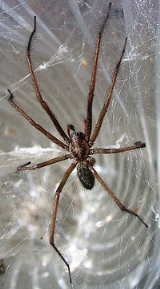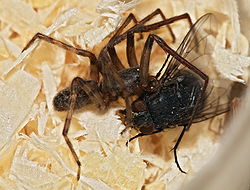
Tegenaria atrica
Encyclopedia

Central Europe
Central Europe or alternatively Middle Europe is a region of the European continent lying between the variously defined areas of Eastern and Western Europe...
and Northern Europe
Northern Europe
Northern Europe is the northern part or region of Europe. Northern Europe typically refers to the seven countries in the northern part of the European subcontinent which includes Denmark, Estonia, Latvia, Lithuania, Norway, Finland and Sweden...
. Females grow up to 1.8 cm, males up to 1.5 cm. Adult males can be found from July to October, adult females occur all year. In UK, it is colloquially referred to as the dust spider or the dustbunny spider for their fondness of building webs around dustbunnies under furniture or behind stock.
Description

Opisthosoma
The opisthosoma is the posterior part of the body in some arthropods, behind the prosoma . It is a distinctive feature of the subphylum Chelicerata...
features a lighter middle line with six "spots" on each side. In contrast to other species in the genus Tegenaria, T. atrica and the smaller T. picta have uniformly colored legs. In other species, the legs are annulated or spotted. In females, the legs are up to twice the body length, in males even three times. They are able to achieve speeds of up to 50 cm/s for short distances.
Its eight eyes are of equal size and are arranged in two rows. As the eyes contain fewer than 400 visual cells, T. atrica can probably only distinguish light and dark.
Biology

T. atrica normally lives for two or three years, but lifetimes of up to six years have been observed. While the female only leaves its nest to feed, the male can be found wandering about during the mating season from June to October.
At least 60 spiderlings emerge from an egg sac. Unusual for spiders, they are subsocial at this stage: they remain together for about a month, but do not cooperate in prey capture. The amount of cannibalism correlates with the amount of available food. T. atrica molts seven or eight times before reaching the immature adult state, and after a final molt reaches maturity.
The Tegenaria Atrica fear humans and they are more runners than hunters if a human comes close.
Distribution
T. atrica is found in EuropeEurope
Europe is, by convention, one of the world's seven continents. Comprising the westernmost peninsula of Eurasia, Europe is generally 'divided' from Asia to its east by the watershed divides of the Ural and Caucasus Mountains, the Ural River, the Caspian and Black Seas, and the waterways connecting...
up to Central Asia
Central Asia
Central Asia is a core region of the Asian continent from the Caspian Sea in the west, China in the east, Afghanistan in the south, and Russia in the north...
and Northern Africa.
In the last few years the spider has been found in several European countries, like Estonia
Estonia
Estonia , officially the Republic of Estonia , is a state in the Baltic region of Northern Europe. It is bordered to the north by the Gulf of Finland, to the west by the Baltic Sea, to the south by Latvia , and to the east by Lake Peipsi and the Russian Federation . Across the Baltic Sea lies...
, Latvia
Latvia
Latvia , officially the Republic of Latvia , is a country in the Baltic region of Northern Europe. It is bordered to the north by Estonia , to the south by Lithuania , to the east by the Russian Federation , to the southeast by Belarus and shares maritime borders to the west with Sweden...
and Lithuania
Lithuania
Lithuania , officially the Republic of Lithuania is a country in Northern Europe, the biggest of the three Baltic states. It is situated along the southeastern shore of the Baltic Sea, whereby to the west lie Sweden and Denmark...
. It was introduced to North America
North America
North America is a continent wholly within the Northern Hemisphere and almost wholly within the Western Hemisphere. It is also considered a northern subcontinent of the Americas...
, where it is now established.
Its original habitat consists mostly of cave
Cave
A cave or cavern is a natural underground space large enough for a human to enter. The term applies to natural cavities some part of which is in total darkness. The word cave also includes smaller spaces like rock shelters, sea caves, and grottos.Speleology is the science of exploration and study...
s, or dry forests where it is found under rocks, but is a common spider in people's homes.

